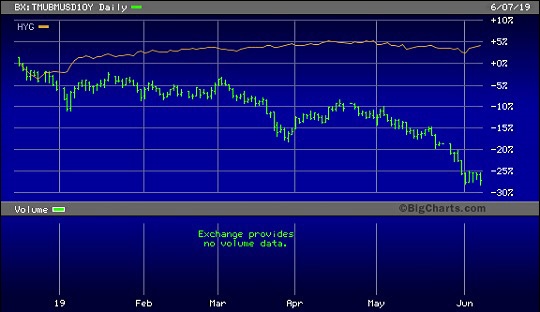Courtesy of Pam Martens
Yield on 10-Year U.S. Treasury Note versus iShares iBoxx High Yield Corporate Bond ETF (HYG) Since December 14, 2018
By Pam Martens and Russ Martens
On Friday markets digested the nonfarm payrolls report from the U.S. Labor Department showing a weak job growth in May of just 75,000. That news adds to a myriad of other economic data, including a slowdown in durable goods orders, that suggest a deceleration of the U.S. economy.
The Atlanta Fed’s closely watched GDPNow indicator is showing a very weak 1.4 percent forecast for the second quarter of this year.
The 10-year U.S. Treasury note has duly noted the deceleration in the economy and has fallen from a yield of 2.9 percent since the middle of December to 2.08 percent at Friday’s close. The yield of the U.S. Treasury has an inverse relationship to its price. That is, as the market value of the Treasury note rises, the yield declines. Thus, as the perception grows that the U.S. economy is decelerating, the value of Treasuries rises from both investor money moving out of the stock market to safe havens as well as the perception that the Federal Reserve will cut interest rates, encouraging investors to buy Treasuries now to lock in yields before they drop further.
This is Market Think 101. What is not Market Think 101 is for high yield bonds (also known as junk bonds) to rally right along with U.S. Treasury notes. But that’s what’s been happening lately.
…




